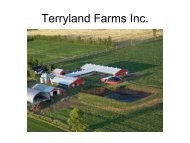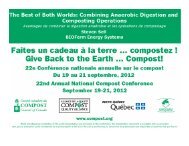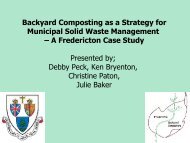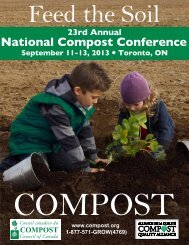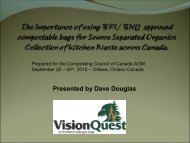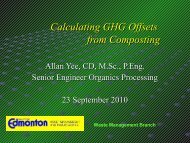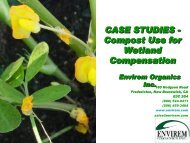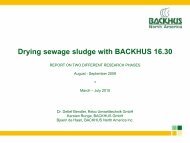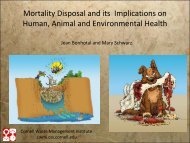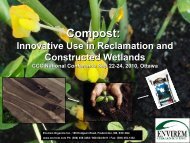Lessons Learned in Aerated Static Pile Composting
Lessons Learned in Aerated Static Pile Composting
Lessons Learned in Aerated Static Pile Composting
Create successful ePaper yourself
Turn your PDF publications into a flip-book with our unique Google optimized e-Paper software.
<strong>Lessons</strong> <strong>Learned</strong> <strong>in</strong> <strong>Aerated</strong><br />
<strong>Static</strong> <strong>Pile</strong> (ASP) Compost<strong>in</strong>g<br />
MICHAEL BRYAN-BROWN, GREEN MOUNTAIN TECHNOLOGIES,<br />
BAINBRIDGE ISLAND, WA<br />
JEFF GAGE, COMPOST DESIGN SERVICES, OLYMPIA, WA
ASP <strong>Lessons</strong> <strong>Learned</strong> Overview<br />
<strong>Pile</strong> porosity, moisture and height must be consistent<br />
<strong>Pile</strong> covers can conta<strong>in</strong> or treat odors but may<br />
restrict airflow rates, slow<strong>in</strong>g the process<br />
Air distribution systems must match feedstock<br />
volatility and the potential rate of decomposition<br />
Temperature and/or oxygen feedback control<br />
systems need to accommodate process extremes<br />
ASP’s are only one part of the compost process<br />
Turn<strong>in</strong>g and rewett<strong>in</strong>g systems must follow for most<br />
energetic feedstock mixtures
Air flow Rates for Maximiz<strong>in</strong>g VS Reduction<br />
Determ<strong>in</strong><strong>in</strong>g the Degree of<br />
Aerobiosis of Compost<strong>in</strong>g<br />
Materials<br />
65° C with bulk<strong>in</strong>g agent<br />
Oxygen discharge<br />
concentrations above 13%<br />
reduced anaerobic pockets<br />
Oxygen consumption rates of<br />
over 4.5 to 8.4 mg O2/g<br />
vs*hr were achieved which<br />
reduced VS at a significantly<br />
higher rate than those below<br />
13%<br />
Klauss, Papadimitriu <strong>in</strong><br />
ORBIT Bioprocess<strong>in</strong>g of<br />
Solid waste and sludge Vol 2<br />
No.1, 2002<br />
Air flow rates are should be<br />
for a 3 meter high pile 35-<br />
40 m³/hr/m² dur<strong>in</strong>g the<br />
high oxygen demand<br />
period of compost<strong>in</strong>g over<br />
the first 3 to 5 days to<br />
provide adequate cool<strong>in</strong>g to<br />
65° C and oxygen levels<br />
above 13% for a green<br />
waste/food waste blend.<br />
This will maximize VS<br />
reduction and dry the pile.<br />
With<strong>in</strong> a large compost pile<br />
the moisture loss = energy<br />
loss = work done
Reduc<strong>in</strong>g Volatile Organic Compound Emissions<br />
Lifecycle VOC emissions from green waste<br />
compost<strong>in</strong>g <strong>in</strong> w<strong>in</strong>drows were measured at less than<br />
one pound of VOCs per ton of compost feedstock<br />
Generation of VOC from Green Waste W<strong>in</strong>drows 70-<br />
80% <strong>in</strong> the first 2 weeks<br />
Doubled VOC emissions by add<strong>in</strong>g Food Waste<br />
Us<strong>in</strong>g compost as a cover reduced emissions by 75%<br />
compared to uncovered pile<br />
San Diego State University - pseudo compost covers report<br />
http://www.ciwmb.ca. gov/publications/organics/44207009.pdf
The Role of ASP’s <strong>in</strong> a Compost Process<br />
Desired Role<br />
Capture and treat<br />
<strong>in</strong>itial odorants dur<strong>in</strong>g<br />
the first 7 to 10 days<br />
Provide temperature<br />
control to meet <strong>in</strong>itial<br />
sanitation<br />
requirements<br />
Significantly reduce<br />
volatile solids<br />
Process Consequence<br />
Media dries as energy<br />
is released as water<br />
vapor<br />
Settl<strong>in</strong>g reduces pile<br />
porosity<br />
Surface precipitation<br />
can create ve<strong>in</strong>s of<br />
saturation<br />
Odors can form<br />
Compost process slows
ASP Systems<br />
Aeration system<br />
Positive aeration<br />
Negative aeration<br />
Alternat<strong>in</strong>g positive<br />
and negative aeration<br />
Cover system<br />
Biofilter layer 15-30 cm<br />
Selective membrane<br />
Wood chips, overs<br />
Perforated membrane<br />
Fixed Biofilter<br />
Biofilter layer 15-30 cm<br />
And<br />
Fixed Biofilter
ASP Systems<br />
Air Distribution Systems<br />
Above ground<br />
perforated pipes<br />
Trenches with<br />
perforated covers<br />
Spargers from pipe<br />
manifolds<br />
Under-pile cavity<br />
form<strong>in</strong>g<br />
Silver Spr<strong>in</strong>gs Organics, Ten<strong>in</strong>o,<br />
Wash<strong>in</strong>gton
Alternat<strong>in</strong>g Direction ASP<br />
Positive w/Biofilter layer<br />
Perforated trench covers at 7” pressure<br />
Negative with Biofilter<br />
Pulled from pile at 10” suction<br />
Lenz Enterprises, Stanwood,<br />
Wash<strong>in</strong>gton, USA
High Tech to<br />
Low Tech<br />
alternat<strong>in</strong>g<br />
directions<br />
West<br />
Yellowstone<br />
Compost<br />
Facility<br />
In-vessel or <strong>in</strong> an open<br />
pile, aerated static piles<br />
can be cheap or<br />
expensive, but must still<br />
be filled carefully to<br />
reduce short circuit<strong>in</strong>g<br />
of air flow.<br />
Consistent porosity<br />
Consistent moisture<br />
No driv<strong>in</strong>g on pile edges<br />
Cold Creek Compost, Ukiah, CA
Assist<strong>in</strong>g<br />
Trench Cover<br />
Systems<br />
Drill out larger holes <strong>in</strong><br />
plates, or add more, but<br />
check air distribution<br />
eng<strong>in</strong>eer<strong>in</strong>g<br />
Lenz<br />
Enterprises,<br />
Stanwood<br />
WA<br />
Place coarse woody<br />
material over the trench<br />
covers<br />
Or better yet, have the<br />
eng<strong>in</strong>eers design the<br />
system for higher<br />
pressures and more air<br />
flow.<br />
Port<br />
Angeles<br />
WWTP<br />
WA
Assist<strong>in</strong>g<br />
Above Ground<br />
Pipe Systems<br />
Same issues as Negative<br />
aeration<br />
1/3 less horsepower<br />
than negative aeration<br />
Perimeter dra<strong>in</strong>age<br />
berm for reduc<strong>in</strong>g<br />
leachate generation<br />
Smaller <strong>in</strong>dividual<br />
blowers per pile can<br />
improve efficiency<br />
Positive Aeration<br />
North Mason Fiber,<br />
Silverdale WA
Assist<strong>in</strong>g<br />
Above Ground<br />
Pipe Systems<br />
Negative aeration<br />
Wash<strong>in</strong>gton State<br />
University, Pullman<br />
Keep pile pipe lengths<br />
relative to diameter or<br />
hole spac<strong>in</strong>g eng<strong>in</strong>eered<br />
for even flow<br />
Sewer perforation pipe<br />
does not work for air<br />
flow distribution<br />
Step down manifold<br />
diameters to ma<strong>in</strong>ta<strong>in</strong><br />
air velocity<br />
Keep pipe velocity<br />
below 15 m/s<br />
Damper seals
Probe<br />
locations<br />
Where you measure<br />
oxygen or temperature<br />
is important to the<br />
control of air flow<br />
Multiple sensors on a<br />
probe allow for<br />
understand<strong>in</strong>g when to<br />
reverse airflow<br />
Check<strong>in</strong>g the<br />
representation of probe<br />
placement is important<br />
as well
Lower<strong>in</strong>g pile<br />
height<br />
Temperature control is<br />
easier the lower you get<br />
A s<strong>in</strong>gle direction air<br />
flow can reach<br />
temperature saturation<br />
(>65°C) <strong>in</strong> 1.2 meters<br />
Revers<strong>in</strong>g air flow<br />
allows for a 2.5 meter<br />
pile to be effectively<br />
cooled
Cover<strong>in</strong>g piles<br />
Cover<strong>in</strong>g piles reduced<br />
the temperature<br />
variability<br />
Condensate forms <strong>in</strong><br />
the top layer<br />
Oxygen levels stayed<br />
high and dry<strong>in</strong>g still<br />
occured
Turn<strong>in</strong>g and<br />
rewett<strong>in</strong>g<br />
It is essential to allow<br />
adequate moisture to be<br />
replaced to cont<strong>in</strong>ue<br />
rapid decompostition<br />
Rewett<strong>in</strong>g dur<strong>in</strong>g<br />
turn<strong>in</strong>g is the best way<br />
to provide uniform<br />
rewett<strong>in</strong>g
Extended pile<br />
stabilization
Extended <strong>Pile</strong><br />
Stabilization<br />
Air flow cont<strong>in</strong>ues<br />
through large particle<br />
redistribution. Even<br />
without forced air
Extended <strong>Pile</strong><br />
Stabilization<br />
Forced aeration<br />
provides significantly<br />
more dry<strong>in</strong>g and<br />
cool<strong>in</strong>g
F<strong>in</strong>ished Compost - Stable <strong>in</strong> 34 days



